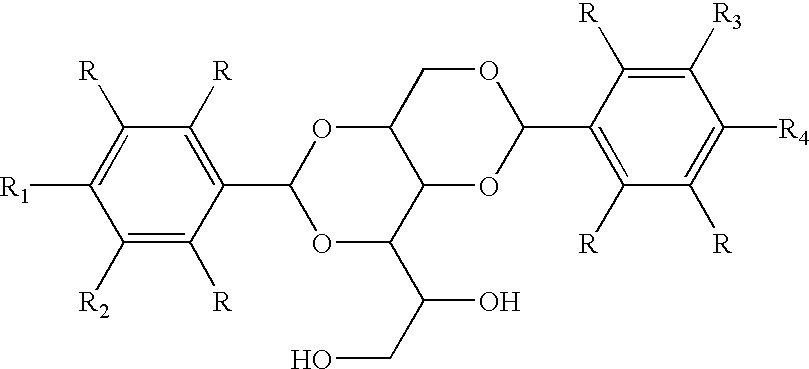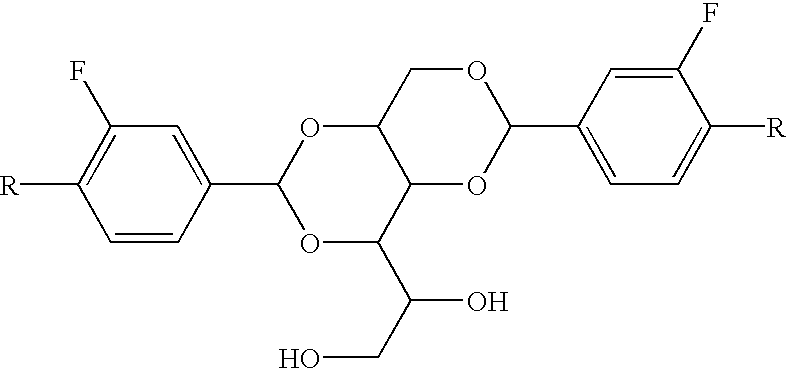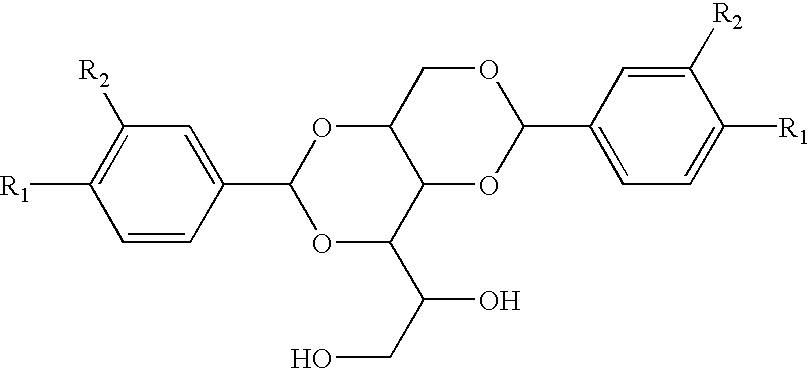Asymmetric dipolar multi-substituted alditol derivatives, methods of making thereof, and compositions and articles containing same
a technology of asymmetric dipolar and multi-substituted alditol, which is applied in the directions of disinfection, organic chemistry, toilet preparations, etc., can solve the problem of difficult separation of individual compounds from reaction product mixtures
- Summary
- Abstract
- Description
- Claims
- Application Information
AI Technical Summary
Problems solved by technology
Method used
Image
Examples
example1
Preparation of Asymmetric 3,4-Dichloro / 3,4-Dimethyl DBS
[0037] A one liter four-necked cylindrical shaped reaction flask equipped with a Dean-Stark trap, condenser, thermometer, nitrogen inlet, and a mechanical stirrer was charged with 42.00 g of sorbitol (0.2306 mole), 700 mL of cyclohexane, 3,4-dichlorobenzaldehyde (40 g, 0.2306 moles), 3,4-dimethylbenzaldehyde (37 g, 0.27 moles), 80 mL of methanol, and 2.5 g of water. p-Toluenesulfonic acid (3 g) was then added upon heating. The reaction then proceeded with increased temperature to reflux. Water was removed continuously from the Dean-Stark trap, and additional solvent was added as needed. After 6 hours, the reaction mixture was cooled and neutralized with 3.3 g of KOH in methanol (40 mL). 500 mL of water was then added, and the cyclohexane layer was then removed azeotropically, producing a residual white solid which was then filtered. The white solid was then washed with water, hot methanol, and oven dried. The product was produce...
example 2
Preparation of Asymmetric 3,4-dichlorobenzylidene / 6-tetrahydronaphthyliden-e sorbitol
[0038] A one liter four-necked cylindrical shaped reaction flask equipped with a Dean-Stark trap, condenser, thermometer, nitrogen inlet, and a mechanical stirrer was charged with 42.00 g of sorbitol (0.2306 moles), 700 mL of cyclohexane, 40.3 g of 3,4-dichlorobenzaldehyde (0.2306 moles), 36.9 of 6-formyltetralin (0.2306 moles), 3.00 g of p-toluenesulfonic acid, and 100 mL of methanol. The reaction was stirred and heated under reflux with removal of water through the Dean Stark trap. The reaction became very thick and additional solvent was added as needed. After about six hours, the reaction was cooled, neutralized with potassium hydroxide, and filtered. The wet cake was washed thoroughly with water and methanol, dried in a vacuum oven at 110.degree. C. to give 72.6 g (61%) of a white powder. The DBS purity was about 99% as judged by GC. Standard analyses of the material indicated that it consisted...
example 3
Preparation of Asymmetric 3,4-Difluoro / 3,4-Dimethyl [50 / 50] DBS
[0039] A one liter four-necked cylindrical shaped reaction flask equipped with a Dean-Stark trap, condenser, thermometer, nitrogen inlet, and a mechanical stirrer was charged with 42.00 g of sorbitol (0.2306 mole), 700 mL of cyclohexane, 40.4 g of 3,4-difluorobenzaldehyde (0.2306 moles), 30.93 g of 3,4-dimethylbenzaldehyde (0.2306 moles), 3.00 g of p-toluenesulfonic acid, and 100 mL of methanol. The reaction was stirred and heated under reflux with removal of water through the Dean Stark trap. The reaction became very thick and additional solvent was added as needed. After about six hours, the reaction was cooled, neutralized with potassium hydroxide, and filtered. The wet cake was washed thoroughly with water and methanol, dried in a vacuum oven at 110.degree. C. to give 78.29 g of a white powder. The purity was about 95% as judged by GC. Standard analyses of the material indicated that it consisted of a mixture of 1,3-...
PUM
| Property | Measurement | Unit |
|---|---|---|
| transparency | aaaaa | aaaaa |
| haze | aaaaa | aaaaa |
| temperature | aaaaa | aaaaa |
Abstract
Description
Claims
Application Information
 Login to View More
Login to View More - R&D
- Intellectual Property
- Life Sciences
- Materials
- Tech Scout
- Unparalleled Data Quality
- Higher Quality Content
- 60% Fewer Hallucinations
Browse by: Latest US Patents, China's latest patents, Technical Efficacy Thesaurus, Application Domain, Technology Topic, Popular Technical Reports.
© 2025 PatSnap. All rights reserved.Legal|Privacy policy|Modern Slavery Act Transparency Statement|Sitemap|About US| Contact US: help@patsnap.com



